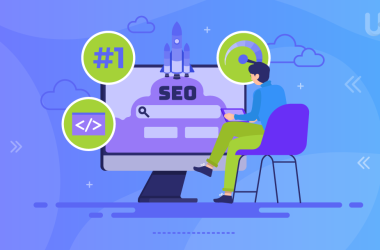Optimizing a website is a complex process that involves many elements, but it is crucial for improving its online visibility and attracting potential customers. However, with knowledge and effort, it is possible to independently optimize a business website in Google search results.
Promoting a business in free search results is one way to reach new customers for large brands, but small business owners can also benefit from being present in Google results. Local businesses often have limited budgets, so the majority of proprietors choose to take on online advertising activities independently.
In this guide, I will show you how to independently optimize a business website to achieve tangible results in SEO.
Step-by-step website optimization process
The website optimization process aims to increase a website’s visibility in search results for specific keywords. Increased visibility should lead to increased traffic to the website and, as a result, additional orders or inquiries from potential customers.
Active promotion on various channels is crucial for increasing sales and acquiring new customers. Creating a website, producing engaging content, and optimizing them for SEO is not enough. In addition to these measures, promoting the website on social media, local portals, and industry-specific websites is essential.
Follow this step-by-step list to optimize your business website and improve your sales!
Creating an offer
Having a website does not guarantee an increase in sales. It doesn’t even guarantee that anyone will visit your website. To reach customers, you need to:
- create an attractive offer;
- stand out from the competition;
- take care of unique content;
- keep the customer on the site longer and encourage them to use your services or buy your product.
Effective website positioning is crucial for increasing sales and acquiring new customers. To achieve it, consider certain elements. First of all, search engine optimization, engaging content, and active promotion on various channels. The best way to create valuable content for your e-commerce from an SEO perspective is to start a blog. Read our article on why an e-commerce store should have a blog.
Without these elements, it is as if your website doesn’t exist at all, like a grocery store in the middle of a forest waiting for lost tourists. Therefore, investing in website optimization to optimize your business website can be the key to success in online business.
Establishing prospective keywords
Although it is not always obvious, customers may use different words from the ones you use to describe the services or products you offer. Therefore, a crucial step in achieving high positions on selected keywords is to discover the phrases that customers use to search for your products or services on search engines.
However, you don’t have to read tea leaves or consult a clairvoyant. Just use one of the many free keyword research tools available. One such tool is the Surfer Keyword browser extension for Chrome, which is available for free. It allows you to see in real-time how popular a given phrase is and discover related keywords with potential.
Another recommended tool is the Keyword Planner, which is part of the Google Ads system. Without an active campaign, you can only view an approximate number of searches for selected phrases. But even that should show you if a keyword has a high search frequency.
You can also search for other keyword research tools on your own, as there are many available.
Assigning keywords to subpages
Once you have compiled a list of compelling keywords, allocate them to relevant subpages showcasing your services. This approach will help you determine which keywords to focus on when optimizing each page.
It’s worth noting that the most effective website positioning strategy involves assigning a single service to each subpage. For instance, if your business offers both apartment cleaning and carpet cleaning, it’s best to create separate subpages for each service.
Creating content for a website
Having just keywords is not enough nowadays. The content on a website is one of the most significant factors that can affect its position in Google search results. It is essential to create valuable content that includes unique photos, charts, tables, etc., to maximize benefits.
Always keep in mind that the content should be crafted for the customers, not just for the search engine bots. An effective tactic is creating infographics that people can share on social media platforms.
If you think that infographics are beyond your reach because you don’t know how to use graphic design software, don’t worry. In the article below, you will find tools that will help you easily prepare killer infographics!
Emphasize the elements that differentiate your company from your competitors and ensure that the text on the website is visually appealing. Utilize bullet points, bold text, and headers, and avoid overwhelming the reader with long paragraphs. Breaking up the content into shorter paragraphs will make it more digestible for the readers.
While creating content, make sure to include the keywords that you have assigned to the specific subpage. Use natural language and avoid grammatical or stylistic errors that could distract your potential customers from your offerings.
Also, do not forget about reviews and references from satisfied customers. It will help build the credibility of the company. Besides, most of us look for information about the offer before using it and make purchasing decisions based on the opinions we find.
If you have several or dozens of subpages, think about how to connect them using links in the content. Internal linking is often an underestimated but effective way to boost your website’s position a few notches up.
Taking care of the technical aspects of a website
Always prioritize user-friendliness. Project a clear and easy-to-navigate menu and intuitive website structure. Think about potential customers and indexing robots.
Pop-up ads
One of the biggest obstacles to smooth surfing is all kinds of pop-up windows that are difficult to close. It is best if such ads do not appear on the website, but if you have to use them, do it in a non-invasive way.
Adapting the website to mobile devices
The user should be able to easily navigate the website on both PC and mobile devices. Responsiveness is currently one of the critical technical issues. Your customers often use smartphones when looking for specific services or products. Googlebot also indexes websites in their mobile version.
Indexation settings
You can’t forget about accessibility for robots and allowing them to add the website to Google’s index. It is important not to block the website’s indexing, as this will prevent it from appearing in the search engine.

URL addresses
When optimizing the technical elements of a website for Google search, consider the URL addresses. Each subpage of the website should have addresses that are easy to remember and indicate their content. Follow best practices for creating URL addresses to make them user-friendly and algorithm-friendly.
Structured data
If you have some programming experience, you can try using structured data. It is a type of content labeling that Google algorithms can use to enhance the addresses appearing in search results. Structured data is often used to display additional information directly in Google search results, such as star ratings, product prices, product availability, or a section of frequently asked questions.
SEO-friendly web hosting
A hosting that is SEO-friendly allows for the optimization of a website for search engines. The proper choice of hosting can impact the speed of website loading and its availability, which is important for positioning in search results.
SEO-friendly hosting should meet several criteria, such as:
- Page loading speed – hosting should provide fast page loading as it is an important factor influencing positioning.
- Server availability – hosting should provide maximum server availability to avoid traffic loss and impact on positioning.
- Security – hosting should have a high level of security to minimize the risk of attacks and impact on positioning.
- Server location – server location can have an impact on page loading speed and positioning in search results for a specific location. So if your customers are primarily located in Europe, choose a reliable VPS hosting in Germany.
- Technical support – hosting should provide fast and effective technical support to minimize the risk of failures and impact on positioning.
Good hosting can help achieve better results in search engines, but it should be remembered that it is only one of the factors influencing positioning. Therefore, it is also worth taking care of other SEO aspects, such as content and backlinks. You can find such hosting in the offer of UltaHost.
Analysis and drawing conclusions
When you have a functional and optimized website, move on to the following stages of positioning your business website on Google. Positioning is a continuous process, so you should carefully monitor the positions of selected keywords and the traffic on the site.
You should know how customers find you, what queries they use to find your website, and what keywords your competition uses.
You can perform such an analysis using Google Analytics, Keyword Planner, and Google Search Console, then conclude and implement the conclusions in the positioning process. Perhaps it will be necessary to re-optimize the website, add CTA, or fix non-functioning buttons. Implement changes after the analysis that will bring you closer to your planned goal.
If you want to position your website manually, you need competitor visibility analysis tools such as Ahrefs or Senuto. Thanks to them, you may observe which keywords your competition focuses on and which content you still need to work on to achieve better results.
Promoting a brand on the internet
To ensure that your website reaches new audiences, engage in content marketing activities. Start by creating a corporate blog where you can share interesting and relevant content, such as texts, photos, multimedia, and infographics. You will attract potential customers, increase your website’s visibility and establish your company as an industry expert.
Make sure to keep your content up-to-date and relevant to your target audience. Utilize social media platforms to promote your content. Another effective approach is guest posting on other relevant blogs or websites, which can help attract new audiences and build your brand’s position in customers’ awareness.

Another advantage of content marketing is that with a bit of luck, your content will start to be linked, providing Google with another reason to increase your website’s visibility. Acquiring links to your website is an essential part of SEO. You can wait for links to appear on their own, but it’s unlikely to happen. That’s why being proactive and trying to get a few links yourself is better.
Sponsoring local events or organizations like a sports team or a book club is a great way to introduce your brand to the local community and may result in a backlink from the organization’s website. Local advertising is also a way to add a link to your website. Collaborating with your suppliers or business partners can also help you gain a few more links to your website.
However, it’s important to avoid mass buying of links of unknown origin, which can harm your website’s ranking rather than help it. You can improve your website’s visibility and search engine ranking by following these tips and utilizing various link-building strategies.
Conclusion
Can you position your website on your own? Yes, you can. Nothing is stopping you from doing it yourself. Most small business owners try to promote their business themselves initially, even though they may experience numerous failures.
When deciding to position your website on your own, remember that this is not a task that can be done on a whim once a month. To achieve the intended effect, you must optimize your business website regularly and consistently. Only then it will be possible to gain rewarded positions in the Google search engine.
If you enjoyed this article, then you’ll love VPS with Cyberpanel from UltaHost. Get 24/7 support from our support team. Our powered infrastructure focuses on auto-scaling, performance, and security. Let us show you the difference! Check out our plans!












